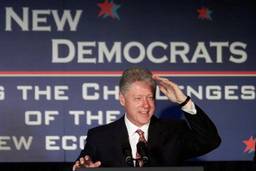Bad Posture
Bushs new nukes and far-flung bases take the war into a dangerous new phase.
Doug Ireland

George W. Bush and his administration are more dangerous than anyone could possibly have imagined before he took office. This is the conclusion correctly drawn by most of the worlds democracies after the tardy revelations about the Pentagons Nuclear Posture Reviewsecretly approved in January but only recently leaked to the Los Angeles Times by frightened congressional sourceswhich reverses the long-standing unofficial U.S. doctrine of no first use of nuclear weapons. Its a cause for serious fear, editorialized Le Monde, while Londons largest-circulation daily, the Mirror, bannered the headline, Lets Nuke Em All.
The new policy contemplates the use of nuclear weapons in circumstances never before approved, including the failure of conventional weapons to destroy military targets, in response to chemical or biological attacks, or in the event of surprising military developmentsa perilously open-ended definition. Even if one sets aside the ethical problems posed by the new doctrine, the move is pure folly that accelerates the dangers of nuclear proliferation.
The doctrine calls for developing a new generation of so-called tactical mini-nukeswhich would have to be tested, of course, violating nuclear testing bans signed by the United States. But Bush wouldnt have to wait: The low-yield B61-11 nuclear bomb, designed to penetrate underground bunkers, is already in the U.S. arsenal and has been deployed in Europe since 1997. (Of course, mini-nuke is a highly misleading vocable: Hitting Saddam Husseins presidential bunker in Baghdad with the B61-11, for example, could cause upwards of 20,000 deaths, according to the Physicians for Social Responsibility.)
At the sub-cabinet level, where real decisions get made and options for political leaders are skewed one way or another, the Bush administration is crammed with proponents of the use of tactical nukes. They include: Stephen Hadley, Bushs deputy national security adviser; Robert Joseph, a member of the National Security Council; Stephen Cambone, now a senior Pentagon policy planner; and William Schneider, another Bush defense counselor. These four co-authored a report published last year by the National Institute for Public Policya conservative think tank funded in part by the military-industrial conglomeratesdeclaring that nuclear weapons can … be used in counterforce attacks that are intended to neutralize enemy military capabilities.
No less than the head of the U.S. Defense Threat Reduction Agency, Stephen Youngerresponsible for counter-proliferation programsexpressed his enthusiasm for small, precision-guided, low-yield nukes in a paper he wrote last year titled Nuclear Weapons in the 21st Century. And Secretary of State Colin Powell, whose flacks have been assiduously portraying him to the gullible Washington press corps as dovish, called the Nuclear Posture Review prudent military planning.
The Bush doctrine has not only changed nuclear weaponry from a tool of deterrence to just another option for war-fighting. It has extended their threat to non-nuclear countries (in further violation of U.S. commitments)including, by name, four Islamic ones. But neither Libya nor Syria have nuke programs. Despite their best efforts, Western intelligence agencies have been unable to uncover any credible evidence that Iraq has restarted its deliverable nuke program, effectively dismantled by U.N. inspectors during the 90s. And Irans nuclear program is stalled and years away from developing usable weapons. Moreover, the new doctrine for the first time proposes the use of nukes to defend against any attack on a roster of U.S. allies, including Israelwhich has its own substantial nuclear arsenal of at least 300 deliverable warheads. Yet from the supine Democratic Party leadership, one has heard not a peep of protest against Bushs new nuclear strategy.
At the same time, in the six months since September 11, the Bush administration has moved to develop new bases in a wide swath of the world and put U.S. forces into action in a greater array of countries than at any time since World War II. Anyone who thinks these new bases will be eliminated once the war on terrorism is over is dreaming.
Bush has established military baseswhich will have combat aircraft and at least 3,000 personnelin the countries of oil-rich Central Asia, including the brutal authoritarian regimes in Uzbekistan, Kyrgystan and Tajikistan. In Georgiawhere Edward Shevardnaze long ago abandoned his image as a democratic reformer to pursue an authoritarian course built on a cult of personalityBush has given enough military aid to triple the countrys military budget, sending in 200 military advisers and dozens of Huey helicopters (which will be used not simply against supposed al-Qaeda forces, but against recalcitrant Chechen and Abkhazian minorities). These bases will only stimulate paranoia in the powerful military establishments in Moscow and Beijing, spurring their demands for more resources and weaponsespecially in light of the Nuclear Posture Review.
In the Philippineswhere, on the island of Basilan, a Manila-directed army of more than 7,000 soldiers has been unable to eliminate less than 100 illuminès of the Abu Sayyaf guerrillas because the local population supports themBush has sent in 660 U.S. troops, 30,000 machine guns and $100 million in military aid, which works out to more than a million bucks for each rebel.
The United States has also sent 100 military advisers to Yemen to help in combat against local tribes, and special forces are going into Sudan to prepare an attack in Somalia. Add to this our existing bases in Turkey, Saudi Arabia and Kuwaitas well as our new bases and troop concentrations in Afghanistan and Pakistan and huge naval patrols in the Red Sea and the Arab Gulfand its no wonder that the world views Washingtons new forward strategy as part of an imperial design at the service of U.S.-dominated globalization.
Given all of the above, Bushs declarationgod bless our coalitionwith the flags of 179 nations as his photo-op background when the White House marked the six-month anniversary of the September 11 attacks, masks the degree to which his simplistic, unilateralist policies (as French foreign minister Hubert Vedrine put it) have spooked the war on terrorism alliance. That, of course, includes his widely reviled axis of evil speech.
Consider Bushs attempt to rally support for a new war on Iraq. In Europe, only the fascist-allied Silvio Berlusconi of Italy and arch-conservative Jose Maria Aznar of Spain unequivocally support it. Tony Blair faces a rare Labor Party revolt against his solidarity with Bush on Iraqeven within his own cabinet. And as Dick Cheney emerged from his bunker for a tour of a dozen nations, including the Middle East, to prepare them for new attacks on Iraq, Jonathan Freedland in the Guardian summed up the position neatly:
There is none of the Arab support that made the 1990-91 Gulf War viable. … The Saudis, nominal joint commanders last time, are begging America to stay away now. Kuwait will not allow itself to be used as a base for U.S. troops. Turkey fears any attempt to stir the Kurds against Baghdad will only energize Turkish Kurds against Ankara. Nor are Shias in southern Iraq likely to join the American effort: They feel betrayed by Bushs father, who called on them to revolt, only to abandon them to their fate. Their backers in Iran are not exactly on side with the Bushies either, not since they were lumped into the axis of evil.
Finally, theres Afghanistan. Declarations of victory over the Taliban and al-Qaeda were premature, as the offensive against their regrouped forces in Gardez and Shah-I-Kot in the east made clear. The Pentagons own numbers tell the story: When the ground campaign began in Afghanistan on October 7, it estimated opposition forces at 35,000 men; but now it admits it has yet to account for 20,000 of them. Theyre not in Cuba nor in the caves. Theyve faded into hospitable Pashtun villages or exfiltrated through the mountains to Pakistan (not counting those buddies the Pakistani intelligence services flew out of harms way under the noses of U.S. forces).
The government of Hamid Karzaihand-picked by the CIA as the interim head of stateis virtually powerless outside Kabul (and his control is shaky therewitness the recent assassination of one of his ministers). And just as the Pentagon was declaring the campaign in Gardez nearly over, Karzais government warned that large numbers of Taliban and al-Qaeda fighters were regrouping across southern Afghanistan in the provinces of Wardak, Ghasni, Khost and Paktia. Karzai ordered 1,000 troops to these Pashtun areasall Tajiks loyal to the Northern Alliance (as were the 1,000 soldiers Karzai previously sent to Gardez with U.S. military approvalprovoking outrage among Pashtun commanders there).
The nefarious consequences of the war in Afghanistan predicted by those of us who opposed it have come true. Warlordism has returned in force, ethnic cleansing of Pashtuns has been reported in the north and east, opium cultivation has aggressively rebounded. Control of drug crops is one reason for internecine armed combat among the erstwhile, purchased U.S. allies at the regional level, as the country spins closer and closer to full-scale civil war.
Americas military campaign continues to kill Afghan civilians. French commanders in Afghanistan have refused to send their Mirage fighter planes on many U.S.-requested missions because they feared murky American targeting would cause even more civilian casualtieslike the March 6 raid in which even the Pentagon admitted women and children were killed. Food aid is being sidetracked by local warlords and turned into a racketonly those villages that pay get food. Malnutrition is stunting the growth and killing untold numbers of Afghan children. And remember Laura Bushs pleas for support of the war to help Afghan women? Karzais womens minister, Dr. Sima Samar, complains that not a single dollar of the aid for womens programs (particularly education) promised by the United States and Britain has yet materialized.
One could go on, but even from these brief summaries it is clear that the militarization of the campaign against terrorism has brought with it new dangers and new slaughters of the innocent. The long war has only heightened global insecurity, not diminished it. And theres worse to come.
The new policy contemplates the use of nuclear weapons in circumstances never before approved, including the failure of conventional weapons to destroy military targets, in response to chemical or biological attacks, or in the event of surprising military developmentsa perilously open-ended definition. Even if one sets aside the ethical problems posed by the new doctrine, the move is pure folly that accelerates the dangers of nuclear proliferation.
The doctrine calls for developing a new generation of so-called tactical mini-nukeswhich would have to be tested, of course, violating nuclear testing bans signed by the United States. But Bush wouldnt have to wait: The low-yield B61-11 nuclear bomb, designed to penetrate underground bunkers, is already in the U.S. arsenal and has been deployed in Europe since 1997. (Of course, mini-nuke is a highly misleading vocable: Hitting Saddam Husseins presidential bunker in Baghdad with the B61-11, for example, could cause upwards of 20,000 deaths, according to the Physicians for Social Responsibility.)
At the sub-cabinet level, where real decisions get made and options for political leaders are skewed one way or another, the Bush administration is crammed with proponents of the use of tactical nukes. They include: Stephen Hadley, Bushs deputy national security adviser; Robert Joseph, a member of the National Security Council; Stephen Cambone, now a senior Pentagon policy planner; and William Schneider, another Bush defense counselor. These four co-authored a report published last year by the National Institute for Public Policya conservative think tank funded in part by the military-industrial conglomeratesdeclaring that nuclear weapons can … be used in counterforce attacks that are intended to neutralize enemy military capabilities.
No less than the head of the U.S. Defense Threat Reduction Agency, Stephen Youngerresponsible for counter-proliferation programsexpressed his enthusiasm for small, precision-guided, low-yield nukes in a paper he wrote last year titled Nuclear Weapons in the 21st Century. And Secretary of State Colin Powell, whose flacks have been assiduously portraying him to the gullible Washington press corps as dovish, called the Nuclear Posture Review prudent military planning.
The Bush doctrine has not only changed nuclear weaponry from a tool of deterrence to just another option for war-fighting. It has extended their threat to non-nuclear countries (in further violation of U.S. commitments)including, by name, four Islamic ones. But neither Libya nor Syria have nuke programs. Despite their best efforts, Western intelligence agencies have been unable to uncover any credible evidence that Iraq has restarted its deliverable nuke program, effectively dismantled by U.N. inspectors during the 90s. And Irans nuclear program is stalled and years away from developing usable weapons. Moreover, the new doctrine for the first time proposes the use of nukes to defend against any attack on a roster of U.S. allies, including Israelwhich has its own substantial nuclear arsenal of at least 300 deliverable warheads. Yet from the supine Democratic Party leadership, one has heard not a peep of protest against Bushs new nuclear strategy.
At the same time, in the six months since September 11, the Bush administration has moved to develop new bases in a wide swath of the world and put U.S. forces into action in a greater array of countries than at any time since World War II. Anyone who thinks these new bases will be eliminated once the war on terrorism is over is dreaming.
Bush has established military baseswhich will have combat aircraft and at least 3,000 personnelin the countries of oil-rich Central Asia, including the brutal authoritarian regimes in Uzbekistan, Kyrgystan and Tajikistan. In Georgiawhere Edward Shevardnaze long ago abandoned his image as a democratic reformer to pursue an authoritarian course built on a cult of personalityBush has given enough military aid to triple the countrys military budget, sending in 200 military advisers and dozens of Huey helicopters (which will be used not simply against supposed al-Qaeda forces, but against recalcitrant Chechen and Abkhazian minorities). These bases will only stimulate paranoia in the powerful military establishments in Moscow and Beijing, spurring their demands for more resources and weaponsespecially in light of the Nuclear Posture Review.
In the Philippineswhere, on the island of Basilan, a Manila-directed army of more than 7,000 soldiers has been unable to eliminate less than 100 illuminès of the Abu Sayyaf guerrillas because the local population supports themBush has sent in 660 U.S. troops, 30,000 machine guns and $100 million in military aid, which works out to more than a million bucks for each rebel.
The United States has also sent 100 military advisers to Yemen to help in combat against local tribes, and special forces are going into Sudan to prepare an attack in Somalia. Add to this our existing bases in Turkey, Saudi Arabia and Kuwaitas well as our new bases and troop concentrations in Afghanistan and Pakistan and huge naval patrols in the Red Sea and the Arab Gulfand its no wonder that the world views Washingtons new forward strategy as part of an imperial design at the service of U.S.-dominated globalization.
Given all of the above, Bushs declarationgod bless our coalitionwith the flags of 179 nations as his photo-op background when the White House marked the six-month anniversary of the September 11 attacks, masks the degree to which his simplistic, unilateralist policies (as French foreign minister Hubert Vedrine put it) have spooked the war on terrorism alliance. That, of course, includes his widely reviled axis of evil speech.
Consider Bushs attempt to rally support for a new war on Iraq. In Europe, only the fascist-allied Silvio Berlusconi of Italy and arch-conservative Jose Maria Aznar of Spain unequivocally support it. Tony Blair faces a rare Labor Party revolt against his solidarity with Bush on Iraqeven within his own cabinet. And as Dick Cheney emerged from his bunker for a tour of a dozen nations, including the Middle East, to prepare them for new attacks on Iraq, Jonathan Freedland in the Guardian summed up the position neatly:
There is none of the Arab support that made the 1990-91 Gulf War viable. … The Saudis, nominal joint commanders last time, are begging America to stay away now. Kuwait will not allow itself to be used as a base for U.S. troops. Turkey fears any attempt to stir the Kurds against Baghdad will only energize Turkish Kurds against Ankara. Nor are Shias in southern Iraq likely to join the American effort: They feel betrayed by Bushs father, who called on them to revolt, only to abandon them to their fate. Their backers in Iran are not exactly on side with the Bushies either, not since they were lumped into the axis of evil.
Finally, theres Afghanistan. Declarations of victory over the Taliban and al-Qaeda were premature, as the offensive against their regrouped forces in Gardez and Shah-I-Kot in the east made clear. The Pentagons own numbers tell the story: When the ground campaign began in Afghanistan on October 7, it estimated opposition forces at 35,000 men; but now it admits it has yet to account for 20,000 of them. Theyre not in Cuba nor in the caves. Theyve faded into hospitable Pashtun villages or exfiltrated through the mountains to Pakistan (not counting those buddies the Pakistani intelligence services flew out of harms way under the noses of U.S. forces).
The government of Hamid Karzaihand-picked by the CIA as the interim head of stateis virtually powerless outside Kabul (and his control is shaky therewitness the recent assassination of one of his ministers). And just as the Pentagon was declaring the campaign in Gardez nearly over, Karzais government warned that large numbers of Taliban and al-Qaeda fighters were regrouping across southern Afghanistan in the provinces of Wardak, Ghasni, Khost and Paktia. Karzai ordered 1,000 troops to these Pashtun areasall Tajiks loyal to the Northern Alliance (as were the 1,000 soldiers Karzai previously sent to Gardez with U.S. military approvalprovoking outrage among Pashtun commanders there).
The nefarious consequences of the war in Afghanistan predicted by those of us who opposed it have come true. Warlordism has returned in force, ethnic cleansing of Pashtuns has been reported in the north and east, opium cultivation has aggressively rebounded. Control of drug crops is one reason for internecine armed combat among the erstwhile, purchased U.S. allies at the regional level, as the country spins closer and closer to full-scale civil war.
Americas military campaign continues to kill Afghan civilians. French commanders in Afghanistan have refused to send their Mirage fighter planes on many U.S.-requested missions because they feared murky American targeting would cause even more civilian casualtieslike the March 6 raid in which even the Pentagon admitted women and children were killed. Food aid is being sidetracked by local warlords and turned into a racketonly those villages that pay get food. Malnutrition is stunting the growth and killing untold numbers of Afghan children. And remember Laura Bushs pleas for support of the war to help Afghan women? Karzais womens minister, Dr. Sima Samar, complains that not a single dollar of the aid for womens programs (particularly education) promised by the United States and Britain has yet materialized.
One could go on, but even from these brief summaries it is clear that the militarization of the campaign against terrorism has brought with it new dangers and new slaughters of the innocent. The long war has only heightened global insecurity, not diminished it. And theres worse to come.
Please consider supporting our work.

I hope you found this article important. Before you leave, I want to ask you to consider supporting our work with a donation. In These Times needs readers like you to help sustain our mission. We don’t depend on—or want—corporate advertising or deep-pocketed billionaires to fund our journalism. We’re supported by you, the reader, so we can focus on covering the issues that matter most to the progressive movement without fear or compromise.
Our work isn’t hidden behind a paywall because of people like you who support our journalism. We want to keep it that way. If you value the work we do and the movements we cover, please consider donating to In These Times.
Doug Ireland has been writing about power, politics and the media since 1977. A former columnist for the Village Voice, the New York Observer and the Paris daily Libération, among others, his articles have appeared everywhere from The Nation to Vanity Fair to POZ. Hes a contributing editor of In These Times. He can be reached through his blog, DIRELAND.







